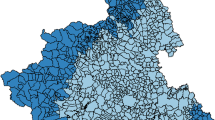Abstract
Radiology is an important pillar of good healthcare. Yet, it is estimated that two-thirds of the world’s population has no or inadequate access to basic X-ray examinations and/or ultrasound. Most of these occur in low to middle income or developing countries. The main reason would be the cost of radiology services, being equipment intensive and resource hungry. Inroads in meeting the acute needs of these countries have been made by some non-profit organizations. One possible innovation to meet this challenge and improve public access to quality radiology and radiation protection is by applying social entrepreneurship. Social entrepreneurship is the application of an unusual or innovative approach to solve a social or environmental problem. The emphasis is on positive social or environmental impact. In practical terms for bridging the radiological divide, it will be through leadership, collaboration and participation. Examples of social radiology include the Physicians Ultrasound in Rwanda Education Initiative, RAD-AID International and the Malaysian College of Radiology’s Value Added Mammogram Program. However, infrastructure, finance, education, policy, equipment maintenance, safety and radiation protection issues must also be addressed to reduce waste and inefficiency. Social entrepreneurship offers an innovative solution to meet societal needs, which is sustainable, pervasive and positive. Financial sustainability may be achieved through grants, donations, a viable business model or a combined approach. Microfinance together with training, impact investments or social impact bonds could help the social entrepreneur to achieve the goals faster. The focus is on pro-active and positive social impact, not just financial goals. It produces results faster, provides an alternative, or assists governments and public sectors to achieve more equitable coverage of quality radiological healthcare including those at the base of the pyramid.
“The test of our progress is not whether we add more to the abundance of those who have much; it is whether we provide enough for those who have too little.” Franklin D. Roosevelt, 20 Jan 1937
Access this chapter
Tax calculation will be finalised at checkout
Purchases are for personal use only
Similar content being viewed by others
References
ASHOKA (2011) www.ashoka.org. Accessed 26 Dec 2011
Clinical Research Centre (2011) National healthcare establishments and workforce statistics (hospital) 2008–2009. https://www.macr.org.my/nhsi/document/Hospitals_Report.pdf. Accessed 7 Jan 2012
Edelson M (2009) Intense vision. Johns Hopkins Dome Magazine. http://www.rad-aid.org/pdf/DOM-RADAID-Article.pdf. Accessed 2 Jan 2012
Global Impact Investing Network (GIIN) (2011) www.thegiin.org. Accessed 26 Dec 2011
Greenemeier L (2010) PET project: radiologists push imaging technologies in developing countries. Scientific American. http://www.scientificamerican.com/article.cfm?id=radiology-developing-countries. Accessed 2 Jan 2012
Ho ELM (2010) Overuse, overdose, overdiagnosis … overreaction? Biomed Imaging Interv J 6(3):e8. http://www.biij.org/2010/3/e8/. Accessed 5 Jan 2012
Ho ELM (2012) Social radiology: where to now? Biomed Imaging Interv J 8(1):e9 (in press)
Hollmann D (2011) NexThought Monday: social impact bonds – an innovative mechanism for social change. Next Billion. http://www.nextbillion.net/blog/social-impact-bonds-innovative-financing. Accessed 3 Jan 2012
IRIS: Impact Reporting & Investment Standards (2011) http://iris.thegiin.org. Accessed 26 Dec 2011
Knowledge@Wharton (2003) Social entrepreneurs: playing the role of change agents in society. http://knowledge.wharton.upenn.edu/article.cfm?articleid=766. Accessed 16 Dec 2011
Lim GCC, Rampal S, Halimah Y (eds) (2008) Cancer incidence in Peninsular Malaysia 2003–2005
Martin RL, Osberg S (2007) Social entrepreneurship: the case for definition. Stanford Social Innovation Review. http://www.ssireview.org/articles/entry/social_entrepreneurship_the_case_for_definition. Accessed 23 Dec 2011
Mollura DJ, Azene EM, Starikovsky A et al (2010) White paper report of the RAD-AID conference on international radiology for developing countries: identifying challenges, opportunities, and strategies for imaging services in the developing world. J Am Coll Radiol 7(7):495–500
National Cancer Registry (2012) http://www.radiologymalaysia.org/Archive/NCR/NCR2003-2005Bk.pdf. Accessed 2 Jan 2012
Ng KH, Mclean ID (2011) Diagnostic radiology in the tropics: technical considerations. Semin Musculoskelet Radiolo 15:441–445
Ng KH, Rehani MM (2006) X ray imaging goes digital. Br Med J 333:765–766
O’Donohoe N, Leijonhufvud C, Saltuk Y et al (2010) Impact investments: an emerging asset class. JP Morgan Global Research. http://www.jpmorgan.com/cm/BlobServer/impact_investments_nov2010.pdf?blobkey=id&blobwhere=1158611333228&blobheader=application%2Fpdf&blobcol=urldata&blobtable=MungoBlobs. Accessed 26 Dec 2011
Project HOPE (2012) http://www.projecthope.org/what-we-do/. Accessed 2 Jan 2012
PURE: Physicians Ultrasound in Rwanda Education Initiative (2011) https://sites.google.com/site/rwandaultrasound/home. Accessed 29 Dec 2011
RAD-AID International (2011) www.rad-aid.org. Accessed 2 Jan 2011
Radiology Malaysia (2011) College of Radiology Academy of Medicine of Malaysia Mammogram Program (2001–2011). http://www.radiologymalaysia.org/breasthealth/smp. Accessed 5 Jan 2012
Radiology Malaysia (2012) Breast Health Information Centre. http://www.radiologymalaysia.org/breasthealth. Accessed 6 Feb 2012
Schwab Foundation for Social Entrepreneurship (2011) www.schwabfound.org. Accessed 26 Dec 2011
Skoll Foundation (2011) www.skollfoundation.org. Accessed 26 Dec 2011
Social Finance UK (2012) http://www.socialfinance.org.uk/. Accessed 3 Jan 2012
The Nobel Peace Prize (2006) http://www.nobelprize.org/nobel_prizes/peace/laureates/2006/. Accessed 12 Dec 2011
Veláquez-Beruman A (2010) WHO perspective on health technologies: medical imaging. Presentation at ESR 2011, Vienna. http://www.who.int/diagnostic_imaging/imaging_modalities/WHOPerspectiveonHealthTech_MedicalImaging.pdf. Accessed 12 Dec 2011
Welling RD, Azene EM, Kalia V et al (2011) White paper report of the 2010 RAD-AID conference on international radiology for developing countries: identifying sustainable strategies for imaging services in the developing world. J Am Coll Radiol 8:556–562
World Health Organization (2011) Essential diagnostic imaging. http://www.who.int/eht/en/DiagnosticImaging.pdf. Accessed 12 Dec 2011
World Health Organization (2011) Baseline country survey on medical devices 2010. http://www.who.int/medical_devices/en/. Accessed 12 Dec 2011
World Health Organization (2011) Medical devices: analysis of results of the baseline country survey 2010. http://www.who.int/gho/health_technologies/medical_devices/medical_equipment/en/. Accessed 12 Dec 2011
World Health Organization (2012) Basic operational frameworks (BOF) for essential health technologies. http://www.who.int/eht/frameworks/en/. Accessed 16 Jan 2012
World Health Report (2010) Health systems financing: the path to universal coverage. http://www.who.int/whr/2010/en/index.html. Accessed 16 Jan 2012
World Resources Institute (2006) Market of the majority: the BOP Opportunity Map of Latin America and the Caribbean. http://pdf.wri.org/market_of_majority_english.pdf. Accessed 4 Jan 2012
Zaharah M, Fatimah O, Sivasampu S (2011) Radiology Devices in Malaysian Hospitals. In: National Medical Device Statistics 2009. https://www.macr.org.my/nhsi/document/NMDS_Report.pdf. Accessed 7 Jan 2012
Author information
Authors and Affiliations
Corresponding author
Editor information
Editors and Affiliations
Rights and permissions
Copyright information
© 2014 Springer Science+Business Media Dordrecht
About this chapter
Cite this chapter
Ho, E.LM. (2014). Bridging the Radiological Healthcare Divide with Social Entrepreneurship. In: Lau, L., Ng, KH. (eds) Radiological Safety and Quality. Springer, Dordrecht. https://doi.org/10.1007/978-94-007-7256-4_24
Download citation
DOI: https://doi.org/10.1007/978-94-007-7256-4_24
Published:
Publisher Name: Springer, Dordrecht
Print ISBN: 978-94-007-7255-7
Online ISBN: 978-94-007-7256-4
eBook Packages: MedicineMedicine (R0)




